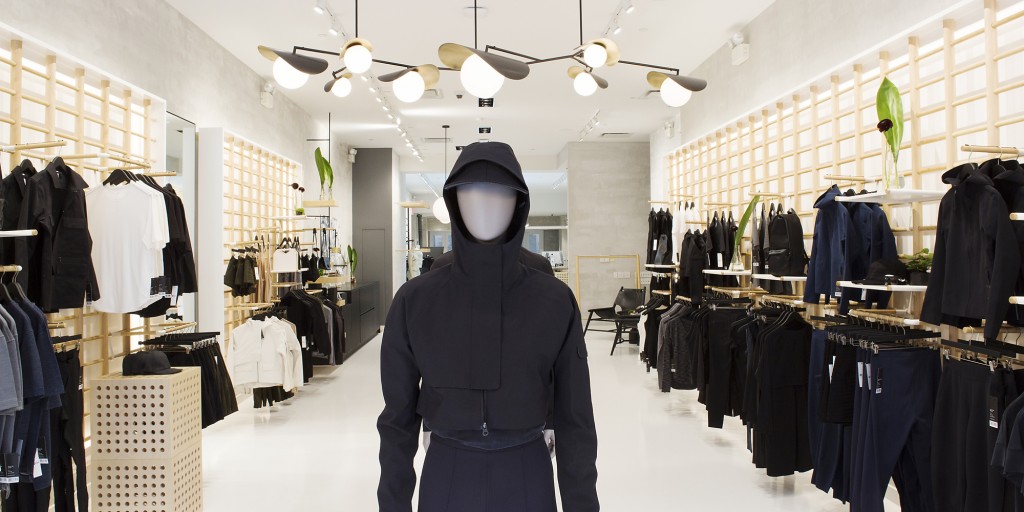Kyle Chayka: Lululemon Lab is cultivating exclusivity in an era of omnipresence.
NEW YORK — Like the social melee of music festivals or the charged atmosphere of the latest well-reviewed restaurant, sometimes the reason retail is compelling is that it’s in physical space rather than online. It’s great to go direct-to-consumer through a well-designed website, but in the age of e-commerce, as even LVMH launches a luxury web outpost, imagine my surprise when I visited a Soho boutique one recent afternoon and was told that nothing in the store was available on the Internet, anywhere.

This was Lululemon Lab, a physical iteration of the athleisure brand that only exists in New York City and Vancouver. If you want the sub-label’s windbreakers, running shorts, or streamlined hoodies, all in technical materials on a strict gradient of white to black, you’ll have to travel. The Soho location is tucked away on the cobblestoned Bond Street, near high-design brands like OAK, APC, and Vitsoe, the maker of luxury modular shelving. Inside, there’s nary a logo in sight, on the walls or the clothing. It’s easy to forget where you are, an appealing prospect for those of us whose opinions of Lululemon were formed watching brunch crowds.
Rather than the informal air of accessible activewear that the brand’s other stores promote — with patterned leggings anyone can look good doing yoga or drinking a mimosa afterward — the Lab is all about cultivating exclusivity. The store’s austere layout, with men to the left and women to the right, highlights just a few key pieces, like a bomber jacket in textured nylon and a sweatshirt with one diagonal zippered pocket. Intermittent showcases on plinths might feature projects like a recent collaboration with the Brooklyn brand Baggu, a reflective pouch you might use to carry groceries or block paparazzi flashes.
In the back of the Lab space, there’s a design office with employees working away on Apple screens amidst mannequins and rolls of fabric. It lends browsing the sense of visiting your local tailor, if the tailor happened to work in arcane hybrids of rubber and cotton. But a look at the labels reveals that though these pieces are proudly designed in NYC the samples that presumably come out of the back office are shipped to factories in Indonesia. Artisanal, not quite.
I first came to the store at the suggestion of a friend visiting from Los Angeles, whose friend in turn had suggested the Lab’s coats as good travel gear: light, protective, and compactable (the winter jacket zips up into a serviceable pillow). Of course, she couldn’t try them out in California, and so New York it was.
Moving past the similarly priced t-shirts, I was drawn to the $180 bomber jacket, a trim, flat version with a few zippered pockets. The texture of the material is a riff on Barbour’s waxed canvas, pleasantly tactile but inorganic and futuristic: The fashion equivalent of a Rimowa suitcase or Bose noise-canceling headphones, redolent of aspirational nomadism. I’m told by the floor attendant that it breaks in well. When I returned to the store a second time, I found a grey version and tried it on.
The Lab store has its issues; it feels slightly provisional, as if it can’t quite decide if it exists. This is heightened by its extant website, a non-interactive signpost for the two physical locations. There are few concessions to hospitality save what looks like a Japanese cold brew beaker filled with drinking water. And then there are the dressing rooms, which are composed of pleasant blonde wood and white panels but are incredibly small, like a Scandinavian jail cell.
I persisted. The bomber jacket fit was perfect and the appeal of the unique material undeniable; I felt like I could chop down a tree made of silicon or repair an iPhone by hand. For a decidedly unathletic person like me, what’s compelling about Lab is its ostentatious functionalism, not for Pilates but perhaps for the unseasonably cool early summer we’re having in the city.
The offline exclusivity also gives the display an urgency: It’s all temporary, and it’s stocked nowhere else. Rather than releasing lines or seasons, Lab does “drops,” streetwear vocabulary adopted by the staff. The stock changes every few weeks as new experiments arrive, and the pieces might not make it into wider production. It’s not unlike Supreme, but rather than the logo, you’re buying into the design. It helps more than the company might appreciate that no one will know where the clothes are from unless you tell them.
I bought the gray bomber jacket thinking it might be good for an upcoming trip to San Francisco. (Send tips!) I declined the offer of a giant, white Lululemon bag because, to my relief, I could fold the jacket up and stash it in my tote (Freitag, which deserves its own review).
The staffer who swiped my card at the Genius Bar-esque counter even seemed in on the distinction of the Lab from the brand at large. When I asked if I could join a store-specific email list, she explained that I was more likely to get all of Lululemon’s promotional material, her expression communicating that this was not a prospect she would enjoy, either. But, she said, I could follow the Lab on Instagram. You can’t completely ignore the Internet.






